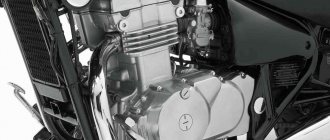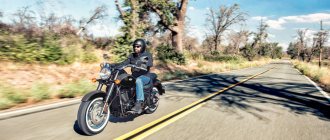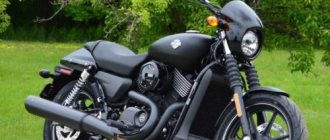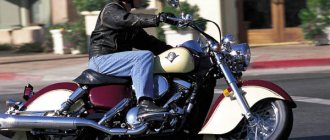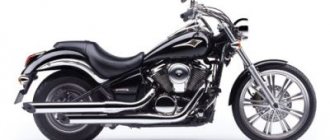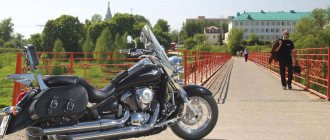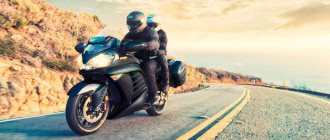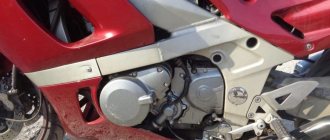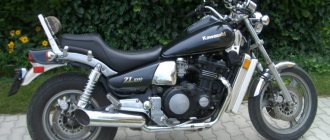The Kawasaki EN 400 Vulcan is one of those motorcycles that is called classic. The untrained eye could easily mistake this cruiser for an American traditional bike. The motorcycle has excellent parameters, although it has not become popular. It was on the basis of this model that the Kawasaki VN 400 Vulcan was subsequently developed.
The EN 400 motorcycle was produced from 1985 to 1994. Although the model did not receive recognition, it gave rise to the magnificent Vulcan series from the Kawasaki concern, which is so loved by many connoisseurs of the golden classics of the two-wheeled world. And at least for this reason EN 400 deserves attention.
Engine
The Japanese equipped the motorcycle with an in-line four-stroke two-cylinder engine, the displacement of which was 398 cubic centimeters. At that time it was good hardware, but the maximum speed that the motorcycle is capable of is only 160 kilometers per hour.
The engine's maximum torque is 33.44 Nm (Newton meters) at 8,000 rpm. Its highest power is 45 horsepower at 9500 rpm. The engine characteristics make the motorcycle quite passable in light off-road conditions.
With a gas tank capacity of 11 liters and consumption of 5-6 liters of gasoline per 100 kilometers, the Kawasaki EN 400 Vulcan was a good choice for long-distance travel, just like many other classic bikes. It wouldn’t be possible to really drive one, but you could enjoy kilometers of flat road, boundless open spaces and solitude.
Review of the Kawasaki EN 400 Vulcan motorcycle
The dynamics are crazy, the bike is responsive, so I had to learn to release the clutch correctly. The first days it shamefully stalled when trying to move away from a traffic light. But keep in mind that this was my first time on a motorcycle. (Rides in Uncle Vasya's Minsk at the dacha don't count) But the combination of a chopper chassis with a high-speed sports engine provides amazing opportunities - should you take a quiet ride while admiring the surrounding nature?
Please. We need to show the shabby little bastard that his place is near the bucket? Easily.
The gears are long, the engine pulls equally well both at low and high speeds, so there is no need to frantically catch the moment when it’s time to change gear. When it works out, then it will switch.
The rear shock absorbers are reliable - they were used under the previous owner, they lasted a season under me (6 thousand) and, as they said at Kamikaze (I recommend them there. Competent, nice guys), at least the season is still going away. I won’t say anything about the fork yet, since, as it turned out, I rode a dead one all season. =)
The seat is very comfortable, so much so that it is already relaxing. I’m thinking of installing a removable backrest for myself (not for the passenger - he already has one) but for myself. By the way, about the passenger. The bike is of course solo. That is, there is a back seat, the passenger sits down, the bike pulls, but (!) it starts to eat quite a bit of fuel. If with me alone, he takes about 5-6 per 100, then with a passenger at least a liter more. In general, as I understand it, the passenger seat is there solely to “take the girl from the bar to the bed.” And it is right ! Women come and go, but the bike lasts a long time.
In general, as soon as I got used to the clutch, I stopped getting off it.
Maybe for the night. The biggest disadvantage, in my opinion, is the lack of a glove compartment. Completely. A tiny little pencil case for some instrument under the seat, I think, is not worth mentioning. So it's time to buy panniers. Gears shift well, and there are no problems with neutral either. Well, it almost doesn't happen.
3 10 times one neutral is not caught immediately. I haven’t figured out the patterns yet.
The same Kamikazovites said that everything was fine with the box, so it’s not a bug, it’s a feature. A ! Main ! I almost forgot. He doesn't have a chain. And not the cardan. He has a BELT!
Moreover, the manufacturers swear that the belt is Kevlar, God knows what, and the warranty mileage of the belt is 800 thousand. I don’t know - I don’t know.. But during the season I was never at all interested in what my engine was transmitting to the rear wheel. That is, no maintenance is required for this node. At all.
It takes turns very easily, holds the turn confidently, that is, although I was afraid every time, there was not a single skid, loss of road or other nasty things.
I put it down, went through the turn, picked it up. (Pah-pah-pah)
The front brake grabs you to death (I almost tumbled over the steering wheel a couple of times), so after a while I learned to pretend to use my hand to imitate ABS =)
The rear brake applies softly and gradually, but if you press harder, it also holds firmly. On a good road, even if the wheel is blocked, it slides straight, but on crap (gravel, cobblestones, dead asphalt) it skids. For some reason it always goes to the right. For the first month I only used the rear brake.
So, the downsides are the lack of a glove compartment, and a tight, sensitive clutch (swing your left hand!)
And the rest are advantages.
A few impressions... The motorcycle is a beast, more of a dragster. I didn’t realize that a chopper could be so sporty, but now if you take a bike, then only a dragster. About the service. Consumables don’t bite, but you need to monitor the condition of the timing chain and tensioner, adjust the valves every 10-12 thousand km, due to the design, and to adjust, you need to drain the cooling system - a small unpleasant detail. The drive is a belt, it runs for a long time, it can easily withstand 50 thousand, but replacement will cost a tidy sum: about 30,000 rubles.
About my personal repair experience: a bike was stolen a couple of years ago and hit a tree. Tank, fork, tidy (rare, like on the LTD 454, with a tachometer), headlight mounts, turn signals (everything), steering wheel in half, the radiator began to sweat, something like this. The steering wheel, from disassembly for 1500 rubles, is straight - it’s actually become more convenient to toss and turn around the city. It hit the radiator because... The procedure “pour 100 grams in 2 weeks” did not bring any particular discomfort. I made the fasteners natively, using (almost) straight hands. The tank was straightened and painted by friends (0 rubles on the Master Card). Turn signals China “chopper type, chrome type” about 1500 per set. The tachometer had to be amputated (it was really inconvenient without it, it wasn’t enough for my eyes). Master Uncle Vova straightened the feathers, everything was perfectly straight (a bubble of 0.5 cognac). A year ago I came across a donor for 20,000, the same bike, ENTIRELY spray painted with black mat (collective farm Herods), dockless. I immediately went to pick it up 300 km away on a Gazelle (3000 to a friend). The bike turned out to be running, the engine was alive. I immediately amputated the fork, the tidy (working!), and the radiator. Now I don't bother at all. A problem happened on the original engine: a washer (no idea where it came from) got between the timing chain and the crankshaft sprocket, the result was removal and disassembly of the engine. Diagnosis - the tensioner and chain are ready. I found a solution right away; in one day I swapped the engines (fortunately, the engine is now a spare part). That's how it happens.
Hodovochka. The volcano is really low. Yes, yes, all the police must be passed carefully, at the speed of a drunken turtle, otherwise the connection of the mufflers from below begins to suffer. The suspension is very soft, but no penetrations were noticed. At speeds the motorcycle feels very confident; at a speed of 130 km/h the truck practically does not notice. The fork is pneumatic-hydraulic, this allows you to more accurately prepare the bike for a specific trip.
The gearbox is 6-speed, which is quite enough. The engine is slightly derated compared to the KLE series, but in sixth gear at a speed of 60 km/h it begins to accelerate quite confidently. You often come across cries for help from the owners, saying they have trouble starting in the cold. This is fine! I almost started to remove my head to check the valves, but I thought better of it in time. The motorcycle in winter (it was necessary, it was necessary) started on only one cylinder, and as it warmed up, sometimes the second one began to turn on. After warming up with a heat gun, the motor worked like clockwork. Overall, an excellent bike for the money, with a moderate appetite, reliable, very nimble. Moreover, with a pusher, the dynamics almost do not change, only the consumption increases slightly.
Dimensions and weight
The Kawasaki EN 400 Vulcan has dimensions similar to those of many classic bikes. The motorcycle is quite tall – 1220 millimeters. Its height at the saddle is 745 millimeters. The width of the bike reaches 820, and the length is 2205 millimeters. The wheelbase of the vehicle is 1485 millimeters.
In terms of curb weight, the motorcycle is not that heavy - only 197 kilograms, which is quite suitable for a classic. Given its size, the EN 400 has the right weight, making the bike balanced, stable and easy to control.
Chassis and brakes
The motorcycle frame is tubular and made of steel. Thanks to its classic design, it gives the bike an exterior characteristic of the “golden” era. In a word – classic!
The rear suspension has a travel of 100 millimeters. It is a pendulum type and has two shock absorbers. The front one is a 36 mm telescopic fork with a stroke of 150 mm.
The wheels look great in relation to the rest of the exterior. The classic look is combined with the classic wheel size: the rear tire reaches 140/90-15, and the front tire reaches 100/90-19.
Kawasaki EN 400 Vulcan has transistor ignition. The steering wheel of the motorcycle is supple and comfortable. It looks stylish, classic, and is equipped with fairly large square mirrors.
The car is equipped with rear drum brakes. The front ones have a single-piston caliper and a disc with a diameter of 300 millimeters. The brakes do their job very well.
text from Motorreview:
Alexey Karklinsky
Kawasaki Vulcan Classic 400: 399 cm3, 33 hp, 150 km/h, $3000-4500
Suzuki Desperado 400: 399 cm3, 33 hp, 153 km/h, $3200-4800
KAWASAKI Vulcan 400. Standard model characteristics: weight - 223 kg seat height - 640 mm engine power - 33 hp. at 8500 rpm max, torque - 32 N.m at 4500 rpm.
Don't believe me? Then try to remember when we could afford a motorcycle as a luxury, as a pleasure? That's the same! He was a means of transportation, a hard worker. Now what? The range of motor vehicles increases every year, and it is becoming more and more difficult to choose a device that suits your liking and capabilities. It is no secret that with the current abundance of goods, motorcycles classified as “choppers” have gained the greatest popularity. This can be argued, but the statistics are inexorable: while representatives of other classes are just becoming fashionable, much more American-style motorcycles are bought than, say, enduro or sportbikes. It is known that everything fashionable is expensive and, choosing “something simpler,” we decided to limit ourselves to a couple of 400 cm3 class choppers. As a result of another attempt to take a closer look and get to know each other better, two nice fat cars fell into our hands: the Suzuki Desperado 400 and the Kawasaki Vulcan Classic 400. Both are in the Japanese format, one might say - half of the adult “eight hundred”.
Shining with an abundance of chrome, rolling around on chubby wheels, importantly puffing out the cheeks of the gas tanks, pressing their bellies to the warm asphalt, both pretentious kids with all their appearance expressed their readiness to prove themselves in action. The road beckons, I didn’t think twice: get in the saddle and hit the road. Somehow I decided to take both motorcycles at once: it’s convenient to compare them, and it’s more fun together. Summer, Saturday, the evening city has thrown off the midday heat, the asphalt heat, along with the summer residents, has left the expanses of embankments and boulevards. A little journey begins. How pleasant it can be to simply drive along empty streets and avenues, slowly, without straining in traffic jams, enjoying the tranquility of a tired city... It seems that the time and transport were chosen well!
Carried away by the contemplation of a charming companion riding the second motorcycle, I did not immediately understand what kind of little animal I got, it turned out to be a Vulcan. It looks like the patch came out with the name, there are no such small volcanoes, and the baby’s character is more than calm. Of course, he tried to impress, he growled bravely, puffed his 200-gram cylinders, and sounded! But he didn't go. That is, of course, he moved quite quickly for his power, but he clearly tried to sound and look a couple of “glasses” more. Dude, though!
Disguised as a rigid rear suspension, it was not going to gently protect the pilot from bumps, but with enviable consistency justified its appearance, bucking on every crack in the asphalt. The front end behaved much more obediently, trying to swallow small irregularities, giving in only to obvious potholes and tram tracks. The “parquet” Vulcan was also disappointing with its meager ground clearance: you might just blow off the engine crankcase on the next road being repaired. However, the low layout also has an advantage - a low center of gravity. As a result, the motorcycle is very docile during maneuvers, especially at low speeds. Even the serious 230 kg of this monster is not perceived as significant. At the same time, stretched out and seemingly pressed to the road, the Vulcan simply does not know how to turn at an angle. The low footpegs begin to squeal heart-rendingly when they come into contact with the asphalt, and many other parts of the motorcycle try to leave an autograph on the uneven streets of Moscow.
One good thing is that driving a Kawasaki does not allow you to go to such extremes. But for leisurely walking, the device is just what you need. I gradually get used to the character of the subject, I begin to think and drive in his style: measuredly, smoothly, without chasing and braking “in the smoke.” There is also a pleasure in this kind of skating - you have time to see everything around, pay attention to the interest of others. And, having poised yourself proudly, you slowly chop further. The archaic in design, but essentially reliable drum rear brake with a mechanical drive works surprisingly well. Of course, the pedal stroke is too long, but the effort is small and can be easily measured even by a small woman’s foot. The front disc brake works at 100, maybe just the force on the handle is too much. However, even the girl didn’t complain: either girls are like that these days, or are my claims too high?
By the way, about the girls: while watching the test participant from the side, I noticed that during the entire trip on the Vulcan she hardly moved at all while driving. I noticed the same thing about myself: a comfortable fit in a soft saddle adequately brightened up the inconvenience of short-travel suspensions. And the girl didn’t even mention the landing. The Vulcan appears to be comfortable for drivers of all sizes.
Having been carried away by the impressions of the motorcycle, I did not immediately notice that Suzuki was increasingly in front. Whether it’s the temperament of a rider, or the piquant appearance of a girl on a chopper, the fact remains: the Desperado is clearly easier to accelerate. The secret turned out to be simple: with absolutely identical power indicators, the Suzuki is almost 30 kg lighter, and the engine, despite its structural similarity to the Kawasaki, is shorter and more revving. Paradox: the clearly more high-torque Vulcan engine, which achieves maximum thrust at lower speeds (4500 rpm), was inferior in acceleration to the “suzuki” “buzzer”. Where has it been seen that the maximum torque of a V-shaped “four hundred” was already at 6000 rpm, with maximum power mode at 7500 rpm? As a result, the completely non-chopper character and lower weight allowed the Suzuki to get ahead, and only simultaneous races in a fixed gear put everything in its place. The Vulcan, puffing sedately, drove away from minimum speed, and only a second or two later, nervously squealing with a twisted engine, the Desperado caught up with it, overtook it and quite confidently retained the lead almost to maximum speed. By the way, the “maximum speed” for both turned out to be low, no more than 150 km/h. The speedometers showed an impressive 165-170 km/h.
It should be noted that already at 120 km/h the desire for further acceleration disappears along with the feeling of comfort. And motors clearly do not favor such modes. After forced “grips,” they “grumble” for a long time, clicking and crackling with their cooling insides: high speeds are not their element. Having had enough of the views of Moscow and the test participant, I have to leave the soft saddle of the Vulcan and change it to a beautiful, but ascetic one from Suzuki. The first impression is like that of a sportbike: the strictly profiled seat is a bit hard, there is no extra space. But it looks like there’s no need for it, it sits like glue, very comfortable. The ergonomics are not much different from the Kawasaki, all the controls are just as accessible, although the handlebars are slightly lower, which makes the riding position feel more dynamic. Perhaps this is one of the reasons for the agility of the motorcycle, which subjectively affects the riding style.
The transition from Vulcan to Desperado slightly sharpened the impressions, the difference in characters became more noticeable. Suzuki suspensions work exactly the opposite: the rear one adequately absorbs almost all irregularities, but the front inverted (on a chopper!) fork diligently transmits the mood and state of the road surface to the pilot’s brain through the arms and neck. It's a shame that there are no settings, except that you can try pouring a liquid of lower viscosity into the feathers. The brakes were amazing. A very sensitive front brake coupled with an inverted fork creates a very nervous alliance. For a chopper, such efficiency and sensitivity are contraindicated: the front wheel locks too easily, and you can “slip.”
The engine turned out to be even more revving than it seemed from the outside - sometimes only the lack of a tachometer stopped it from sportbike promotion. The engine willingly picks up speed with a characteristic “suzuki” squeal to a piercing note, a complete shock! What about style? Where is the characteristic pickup from the bottom? It seems that at the time of development, the idea of creating at least a sports tourist was stuck in the minds of the designers. How else can we explain such a discrepancy between the engine and chassis? You get used to everything, but rushing around on a chopper, nervously clicking through gears, is nonsense. Upon closer inspection, this inconsistency is not the only departure from style. The motorcycle has cast wheels, a rigid (by style standards) chassis, and a seating position with a noticeable forward inclination. A natural question arises: did the designers go too far with progressive solutions? The young chopper turned out to be too lively. To sum up our short acquaintance, I note that both motorcycles clearly do not pretend to be modest; they are “dudes” even more so than their larger brothers. And although their capabilities are not so serious, they look very dignified and attractive on the road. And even if for some they become a step along the way, others will fall in love with them for a long time. Everyone will get their own sea of pleasure from contemplation, possession and small trips on pretentious city slickers. SUMMARY
Despite their external similarity, the motorcycles turned out to be completely different in character and behavior, demonstrating their focus on consumers with different temperaments. The main thing that they have in common is that the price matches the quality, or rather, the quantity of a motorcycle for modest money. Style and pathos at reasonable costs.
History of changes
The Kawasaki EH 400 Vulcan has undergone major changes for almost ten years:
- 1985 – the first generation came out;
- 1987 – a passenger backrest appeared;
- 1989 – the model was not produced this year;
- 1990 – second generation, now with spoked wheels;
- 1992 – the bike is no longer produced;
- 1994 – last year of production, minor cosmetic changes.
And then this quite good motorcycle was replaced by a new, more advanced model, known as the VN 400 Vulcan.
Don't assume that this bike has disappeared without a trace. The developments embodied in its design were inherited by other motorcycles of the legendary Vulcan series. Unpopular and undeservedly forgotten, the Kawasaki EN 400 Vulcan will forever remain in history as one of the founders of the famous line.
